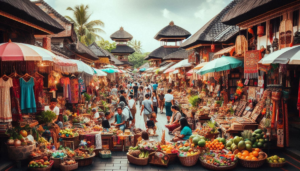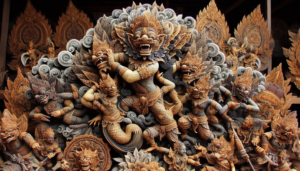
Bali Bliss
The enchanting island of Bali in Indonesia has long been a magnet for travelers seeking paradise. Located in the heart of the Indonesian archipelago, Bali is a gem that captivates the imagination with its stunning natural beauty, rich cultural heritage, and warm, welcoming people. Known as the “Island of the Gods,” Bali offers diverse experiences to all types of travelers, from adventure seekers to those looking for quiet relaxation.
As you set foot on this tropical paradise, you will be greeted by lush landscapes, ranging from lush rice fields and dense forests to volcanic mountains and pristine beaches. Bali’s vibrant culture is infused into every aspect of life on the island, with intricate temples, traditional dances, and colorful festivals as a constant reminder of its deep spiritual roots. The island is also a hub of artists and craftsmen, making it a treasure trove of unique and beautiful creations.
Whether you’re indulging in the local cuisine, exploring the underwater wonders of its coral reefs, or simply sunbathing on its golden sands, Bali promises an unforgettable experience. Here are five things that make Bali famous and a must-visit destination for anyone dreaming of a perfect vacation.
In 2024, Bali will continue to attract a growing number of Indian tourists attracted by the island’s stunning landscape and rich cultural experiences. Indian travelers are drawn to Bali not only for its breathtaking beaches and lush rice fields but also for its vibrant art scene and traditional ceremonies, which offer a unique glimpse into Balinese culture.
With direct flights from major Indian cities and a variety of luxurious accommodations that cater to different preferences, Bali has become a popular choice for Indian honeymooners, families, and adventure seekers. The island’s warm hospitality and diverse cuisine, including options to suit Indian tastes, further add to its appeal, making Bali a favorite destination for Indian tourists looking for both relaxation and exploration.
Bali: 5 Things This Tropical Paradise is Famous For
The enchanting island of Bali in Indonesia has long been a magnet for travelers looking for a slice of paradise. From its spectacular scenery to its rich culture, Bali offers a wide range of experiences that captivate the hearts of tourists. Here are five things that make Bali famous and a must-visit destination for anyone dreaming of an unforgettable vacation.
1. Breathtaking Beaches

Bali’s beaches are legendary, offering various experiences for all types of travelers. The island’s coastline is dotted with a variety of beaches, each with its unique charm and allure. Here are some of the most breathtaking beaches in Bali that will surely leave you mesmerized:
Kuta Beach
Kuta Beach is perhaps Bali’s most famous beach, known for its lively atmosphere and beautiful sunsets. It is a favorite spot for surfers, with waves suitable for both beginners and seasoned pros. The beach is surrounded by lively bars, restaurants, and shops, making it a bustling hub of activity both day and night. Sunbathers can relax on the golden sands, while thrill-seekers can enjoy water sports like surfing, parasailing, and jet skiing.
Seminyak Beach
A short distance from Kuta, Seminyak Beach offers a more luxurious and sophisticated beach experience. The beach is known for its luxurious resorts, chic beach clubs, and world-class dining options. It’s a great place to relax in style, with comfortable loungers and cabanas available for rent. The beach is also a great place to watch the sunset, with many beachfront bars offering happy hour specials and live music.
Nusa Dua Beach
Nusa Dua Beach is famous for its pristine, white sands and crystal-clear waters. It’s an ideal spot for families and individuals looking for a peaceful beach getaway. The calm waters are perfect for swimming and snorkeling, and the beach is surrounded by some of Bali’s most luxurious resorts. Nusa Dua also has a well-maintained promenade, perfect for a relaxing stroll along the beach.
Jimbaran Beach
Famous for its seafood restaurants, Jimbaran Beach offers a unique dining experience right on the sand. As the sun sets, the beach transforms into a romantic dining destination, with tables set up along the shoreline. Freshly caught seafood is grilled to perfection and served with local Balinese flavors. Gentle waves and soft sand make Jimbaran Beach a perfect spot for a relaxing evening by the sea.
Padang Padang Beach
Hidden beneath a rugged cliff, Padang Padang Beach is a small but stunning beach known for its clear turquoise waters and dramatic rock formations. It is a popular spot for surfers, with powerful waves attracting experienced riders from all over the world. To reach the beach, visitors must descend a steep staircase through a narrow cave-like entrance, which adds a sense of adventure to the experience. Once there, you will find a calm beach ideal for swimming and sunbathing.
Uluwatu Beach
Uluwatu Beach is famous for its impressive cliffs and world-class surf breaks. This beach is located below the iconic Uluwatu Temple, with spectacular views of the Indian Ocean. Surfers come to Uluwatu for its challenging waves, while non-surfers can enjoy the stunning views and watch the action from one of the cafes located along the cliff. The beach is also known for its vibrant sunset view, where visitors can relax with a drink and watch the sky turn brilliant shades of orange and pink.
Sanur Beach
Sanur Beach offers a more relaxed and family-friendly atmosphere than the busier beaches on the west coast of the island. The calm, shallow waters are perfect for swimming and snorkeling, making it a favorite for families with young children. The long beach promenade is ideal for cycling, jogging, or a stroll, with plenty of cafes and shops to visit along the way. Sanur Beach also offers stunning sunrise views, providing a peaceful start to the day.
Conclusion
Bali’s beaches offer something for everyone, whether you’re looking for adventure, relaxation, or both. Each beach has its unique character and beauty, making it easy to understand why Bali is celebrated as a top beach destination. Whether you’re catching waves, sunbathing, or enjoying a meal on the beach, Bali’s breathtaking beaches promise unforgettable moments and a perfect escape to paradise.
2. Iconic Temples

Bali, often referred to as the “Island of the Gods,” is home to thousands of temples, each with its unique history, architecture, and spiritual significance. These temples are not only places of worship but also cultural sites that offer a glimpse into the island’s rich spiritual heritage. Here are some of the most iconic temples you shouldn’t miss during your trip to Bali.
Tanah Lot Temple
Tanah Lot Temple is one of Bali’s most famous and photographed temples. Located on a rocky cliff surrounded by the ocean, this temple is a stunning example of Balinese architecture and spiritual tradition. Tanah Lot means ‘land in the sea,’ and this temple is dedicated to the gods of the sea. It is especially beautiful at sunset when the temple is silhouetted against the vibrant colors of the sky.
- History: Built in the 16th century by Dang Hyang Nirartha, a revered Hindu priest.
- Significance: This temple is a pilgrimage site and plays a central role in Bali’s mythology and religion.
- Tip for visitors: Arrive early to avoid the crowds and explore the surrounding area, which is filled with small shrines and souvenir shops.
Uluwatu Temple
Uluwatu Temple is located on a cliff about 70 meters above the Indian Ocean, providing breathtaking views and a dramatic setting. The temple is famous for its traditional Kecak dance performances held at sunset, which tell the story of the Ramayana through song and dance.
- History: Uluwatu Temple dates back to the 10th century and is believed to protect Bali from evil sea spirits.
- Significance: It is one of Bali’s six major temples (Sad Kahyangan), which are considered the spiritual pillars of the island.
- Tip for visitors: Wear the sarong and sash provided at the entrance as a mark of respect. Beware of the monkeys around the temple – they are known to be quite mischievous!
Besaki Temple
Considered Bali’s premier temple, Besaki Temple is the island’s most massive and sacred temple complex. It is located on the slopes of Mount Agung, Bali’s tallest volcano. The complex consists of 23 separate but related temples, the largest and most important of which is Pura Penataran Agung.
- History: The temple is more than 1,000 years old and has survived several volcanic eruptions, including Mount Agung’s major eruption in 1963.
- Significance: Besaki is the focal point of religious ceremonies and is considered the most important temple for Balinese Hindus.
- Visitor Tip: To fully enjoy the temple complex, consider hiring a local guide who can explain the significance of the various temples and rituals.
Tirta Empul Temple
Tirta Empul Temple is famous for its sacred spring water, where Balinese Hindus go for purification rituals. The temple complex is a national cultural heritage site and includes bathing structures, where people can take part in the purification process by bathing in the sacred waters.
- History: Built during the Varmadeva dynasty in 962 AD.
- Significance: The temple is dedicated to Vishnu, the Hindu god of water, and the water from the falls is believed to have healing properties.
- Tips for visitors: Participate in the purification ritual for a unique spiritual experience, but remember to dress modestly and follow local customs.
Goa Gajah (Elephant Cave)
Goa Gajah, also known as the Elephant Cave, is an important archaeological site and a place of meditation. The cave entrance has intricate carvings of a demon’s mouth, through which visitors must enter the cave.
- History: The cave dates back to the 9th century and was initially used as a sanctuary for Buddhist monks.
- Significance: Inside the cave, you will find both Hindu and Buddhist relics, reflecting Bali’s unique blend of religious influences.
- Visitor Tip: Explore the cave and surrounding gardens, which include ancient bathing pools and a beautiful forest setting.
Conclusion
Bali’s iconic temples are more than just tourist attractions; they are the living, breathing embodiment of the island’s spiritual heart. Each temple offers a unique insight into Bali’s culture, history, and religious practices. Visiting these temples not only enriches your travel experience but also deepens your appreciation for the intense spirituality that pervades every aspect of life in Bali.
3. Vibrant Culture and Traditions

Bali’s vibrant culture and traditions are integral to the island’s identity and charm, deeply influencing its daily life, arts, and community spirit. Here’s an in-depth look at what makes Balinese culture so appealing:
Festivals and Celebrations
Bali’s culture is rich with festivals and celebrations, each with its own significance and unique customs. These events are a reflection of the island’s spiritual devotion and community spirit.
- Galungan and Kuningan: One of the most important festivals in Bali, Galungan celebrates the victory of Dharma (goodness) over Adharma (evil). It marks the time when the spirits of ancestors visit Earth. Homes and temples are decorated with penjor (bamboo poles decorated with offerings), and families gather to make offerings and participate in rituals. Kuningan, which takes place ten days after Galungan, marks the return of ancestors to the spiritual realm.
- Nyepi (Day of Silence): Nyepi is Bali’s New Year, based on the Saka calendar. It is a day of complete silence, fasting, and meditation. The day before Nyepi, the Ogoh-ogoh parade is held, where large, colorful effigies representing evil spirits are carried through the streets and then burned to purify the island of negative energies.
- Odalan: Temple anniversaries, known as Odalan, are celebrated every 210 days. Each temple has its own Odalan, which involves elaborate rituals, music, dance, and community feasts. These events are a vibrant display of devotion and community participation.
Traditional Dances
Balinese dances are a fascinating mix of intricate movements, expressive gestures, and elaborate costumes, often telling stories from the Hindu epics or local folklore.
- Barong Dance: This dance depicts the eternal battle between good (Barong) and evil (Rangda). The lion-like creature, Barong, symbolizes protection, while Rangda is a fearsome witch. This dance is a dramatic and mesmerizing performance, full of symbolic gestures and vibrant costumes.
- Legong Dance: Known for its beauty and grace, the Legong Dance is performed by young girls and features intricate finger movements, complex footwork, and expressive facial expressions. It often tells stories of love and heroism.
- Kecak Dance: Also known as the Ramayana Monkey Chant, the Kecak Dance is performed by a group of men who create rhythmic chants and movements to tell the story of the Ramayana, particularly the story of Sita’s rescue by her husband Rama, including the aid of the monkey god Hanuman. This dance, usually performed at sunset against the backdrop of the Uluwatu Temple, is a spectacular and enchanting experience.
Arts and Crafts
Bali’s artistic heritage is renowned worldwide, where traditional crafts play an important role in cultural expression and daily life.
- Batik and Ikat: These traditional textile arts involve intricate patterns and vibrant colors. Batik is created using a wax-resist dyeing technique, while Ikat involves dyeing the thread before it is woven into patterns. Each region of Bali has its distinctive styles and motifs.
- Wood Carvings and Stone Sculptures: Balinese artisans are very skilled at creating wood carvings and stone sculptures. These crafts are evident in the detailed carvings found in temples, homes, and public spaces. Common themes include deities, mythical creatures, and intricate floral patterns.
- Paintings: Traditional Balinese painting is characterized by its detailed and symbolic nature. Themes often revolve around religious and mythological stories. The city of Ubud is the center of Balinese art, with many galleries and workshops displaying both traditional and contemporary works.
Daily Offerings
Daily offerings, known as Canang Sari, are a core aspect of Balinese Hindu practice. These small, handmade offerings, made from banana leaves, flowers, and rice, are placed in temples, homes, and even on the streets as a sign of gratitude and devotion to the gods. The creation and presentation of these offerings is a daily ritual that underscores the Balinese belief in harmony and balance in life.
Conclusion
Bali’s vibrant culture and traditions are a fabric of spiritual devotion, artistic expression, and communal harmony. Whether through its colorful festivals, intricate dances, or daily rituals, the island’s cultural richness offers visitors an intense and immersive experience. Connecting with these traditions provides a deeper understanding of Bali’s unique way of life and the enduring spirit of its people.
4. Lush Rice Terraces

Bali’s lush rice fields are among the most iconic and picturesque landscapes on the island. These terraces are not only a testament to the island’s agricultural practices but also an important part of its cultural heritage. Here’s a detailed look at what makes Bali’s rice fields so special:
Tegallalang Rice Terraces
Located in the village of Tegallalang, just north of Ubud, the Tegallalang Rice Terraces are one of the most famous and frequently photographed landmarks in Bali. These terraces are known for their stunning, emerald-green fields that cascade down the valley slopes, creating a mesmerizing, layered effect. The beauty of Tegallalang lies in its intricate layout and the way it blends harmoniously with the surrounding natural environment.
Visitors can walk through the terraces on narrow paths that wind through the fields, offering various vantage points for breathtaking views and photo opportunities. The area also has small cafes and stalls where you can enjoy a refreshing drink while taking in the view.
Jatiluwih Rice Terraces
The Jatiluwih Rice Terraces, located in Tabanan Regency, offer a more spacious and less crowded alternative to Tegallalang. These terraces cover an area of more than 600 hectares and are a UNESCO World Heritage Site. The Jatiluwih terraces are famous for their traditional Subak irrigation system, which dates back to the 9th century and showcases the sophisticated agricultural engineering of the Balinese people.
Wandering Jatiluwih on foot or bicycle offers a tranquil experience, with panoramic views of vast rice fields, lush hills, and the distant peaks of Mount Batukaru. The area is also home to traditional Balinese villages, where you can watch local farmers at work and learn about the rice farming process.
Subak Irrigation System
A prominent feature of Bali’s rice terraces is the Subak irrigation system, a centuries-old water management method that reflects Bali’s philosophy of Tri Hita Karana, which emphasizes harmony between people, nature, and the spiritual world. The Subak system relies on a cooperative approach, where water is shared equally among farmers, ensuring that each rice terrace receives adequate irrigation.
The system consists of a network of canals, tunnels, and dams that divert water from natural springs and rivers to the rice fields. This sustainable method of water management not only supports rice cultivation but also helps maintain the ecological balance of the region.
Cultural Significance
Bali’s rice terraces are more than just agricultural landscapes; they hold deep cultural and spiritual significance for the people of Bali. Rice is a staple food and a symbol of prosperity and sustenance. The process of rice cultivation is intertwined with religious rituals and ceremonies that honor Dewi Sri, the Balinese goddess of rice and fertility.
Throughout the year, you can witness various ceremonies and offerings in the rice fields, where farmers express gratitude for bountiful harvests and ask for blessings for future crops. These rituals highlight the close connection between the Balinese people and their natural environment.
Ecotourism and Sustainability
In recent years, there has been a growing emphasis on sustainable tourism in Bali’s rice terraces. Efforts are being made to preserve these landscapes and promote environmentally friendly practices. Visitors are encouraged to respect the environment, support local communities, and participate in activities that promote cultural exchange and environmental conservation.
By exploring Bali’s rice terraces, you not only experience their stunning beauty but also gain a deeper understanding of the island’s rich agricultural heritage and the values that guide the Balinese way of life.
5. Thriving Arts and Crafts Scene

Bali’s rich arts and crafts are a vibrant reflection of creativity and tradition, attracting art lovers from all over the world. The island is a treasure trove of artistic expression, where ancient techniques blend seamlessly with contemporary innovation. Here’s a detailed look at what makes Bali’s arts and crafts so unique and fascinating.
Ubud: The Cultural Heart of Bali
At the heart of Bali’s artistic world lies Ubud, a city synonymous with creativity and cultural heritage. Often referred to as the cultural heart of Bali, Ubud is a hub of artists, craftsmen, and art lovers. The streets of Ubud are lined with galleries, studios, and markets, each offering a glimpse of the island’s artistic soul.
The Ubud Art Market, also known as Pasar Seni Ubud, is a bustling market where you can find a wide variety of handmade art. From beautifully carved wooden sculptures and traditional woven bags to intricate silver jewelry and colorful paintings, this market is a haven for those seeking unique souvenirs and artifacts.
Traditional Techniques and Contemporary Innovations
Bali’s artisans are masters of traditional techniques that have been passed down for generations. For example, wood carving is a revered craft in Bali. Skilled carvers create intricate designs, often depicting scenes from Hindu mythology, nature, and daily life. Villages like Mas and Tegallalang are famous for their exquisite wood carvings, where visitors can watch artisans work and even have custom pieces made.
Batik and ikebana textiles are another highlight of Bali’s craftsmanship. Batik involves a complex process of dyeing fabric using wax-resist techniques, resulting in stunning patterns and motifs. Tenganan village is famous for its double ikat textiles, a rare and intricate weaving technique that creates beautiful, richly colored fabrics.
Artistic centers and museums
In addition to local markets and villages, Bali has many museums and cultural centers dedicated to preserving and promoting its artistic heritage. The Agung Rai Art Museum (ARMA) in Ubud displays a diverse collection of traditional Balinese art, contemporary work, and masterpieces from across Indonesia. Visitors can immerse themselves in the island’s artistic heritage through exhibitions, workshops, and performances.
The Neka Art Museum, also in Ubud, offers a comprehensive look at the development of Balinese art. Founded by Balinese art collector Suteja Neka, the museum houses an impressive collection of paintings, sculptures, and photography, offering insight into the island’s artistic journey.
Arts festivals and workshops
Bali’s arts and crafts scene is dynamic, with many festivals and workshops celebrating the island’s creativity. The Ubud Writers and Readers Festival is an annual event that brings together writers, artists, and thinkers from around the world. It is a platform for sharing stories, ideas, and inspirations, reflecting Bali’s role as a cultural melting pot.
For those who want to try their hand, Bali has a plethora of workshops where visitors can learn traditional crafts from local artisans. Whether it’s a batik painting class, a silver jewelry-making workshop, or a wood carving session, these experiences give you the chance to connect with Balinese culture in a meaningful way.
Conclusion
Bali’s thriving arts and crafts scene is a testament to the island’s rich cultural heritage and its enduring spirit of creativity. From traditional techniques to contemporary innovations, Bali’s artistic landscape is as diverse as it is inspiring. Whether you’re a casual observer or a passionate art lover, Bali’s arts and crafts offer a unique and enriching experience, inviting you to explore, create, and connect with the island’s vibrant artistic soul.

Pingback: Best Time for Bali: Discover the Ideal Months to Visit for a Perfect Getaway in 2024
Pingback: Affordable Bali Living Costs for a Week: Experience Paradise for Less Than $300
Pingback: Bali Visa: 5 Key Benefits That Make Your Bali Adventure Unforgettable